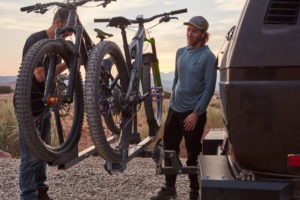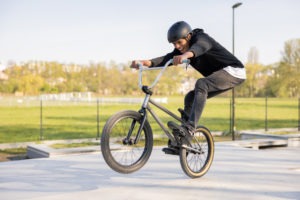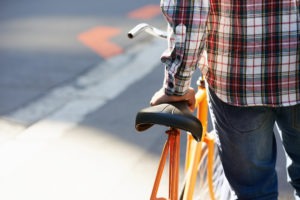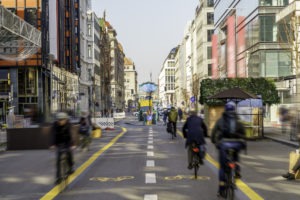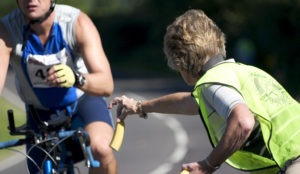There are a thousand and one reasons why riding a bike should be a part of everyone’s lifestyle. You can get some exercise while running to the store for a 6-pack. Spend less on gas and save up for a new bike while commuting to work. Savor that extra 20 minutes of sleep as you cruise past walkers on campus. Cut down on carbon emissions and pedal your way to dinner and a movie. Get some fresh air! And get in the best shape of your life if you train like Lance Armstrong.
Whatever your biking intentions may be, there are a number of different bicycle options to suite your needs. The goal of this article is to help beginners, casual riders or those who haven’t ridden in a while to select the right type of bike for them. See The House Outdoor Gear’s complete selection of bikes.
Fat Bikes
Best For: Snow and sand.
Description: A fat bike has over-sized tires, typically 3.7″ or larger, designed for riding on soft, unstable terrain such as snow and sand. They feature large frames with bigger than normal forks and stays to accommodate the wide rims required to fit these tires.
See Fat Bikes
Single Speed Bikes
Best For: Pavement, gravel, dirt depending on the s bike style.
Description: A single speed bike has one single gear. They are much lighter weight since they don’t have derailleur gears, hub gearing, shifters, cables, extra sprockets or a long chain. A single speed runs the chain in a perfectly straight line from sprocket to chainwheel, and avoids the serpentine wind through the pullies of a derailer. You can really feel the difference! A singlespeed is noticeably quicker and easier to pedal than a multispeed bike in the same gain ratio.
See Single Speed Bikes
Fixie/Fixed Gear Bikes
Best For: Pavement
Description: Fixed gear bikes do not contain a freewheel mechanism and (usually) only one gear. While long associated with track cycling, fixed-gear bikes have become popular with urban riders for their simplicity, low maintenance and low weight. Many use them solely for commuting purposes.
See Fixie/lFixed Gear Bikes
City Bikes
Best For: Pavement or some gravel roads.
Description: Also known as a European city bike, city bikes are designed for frequent short, moderately paced rides through relatively flat urban ares. The frame is a form of utility bicycle commonly seen around the world, designed to facilitate everyday riding in normal clothes in a variety of weather conditions.
See City Bikes
Commuter Bikes
Best For: Pavement or some gravel roads.
Description: Urban bikes are rugged and sturdy with tough frames and strong wheels. They’re designed for city streets – sometimes smooth, sometimes bumpy and perhaps some cracks in the road. Commuter bikes feature an upright riding position that gives the rider and motorists better visibility. Lights, racks and fenders are common on commuter bikes.
See Commuter Bikes
Hybrid Bikes
Best For: Pavement or gravel/dirt roads.
Description: Hybrid bikes offer the best of both worlds, combining benefits of road and comfort bikes. They have a comfortable seat, upright sitting position and (often) suspension forks and/or seat posts. Hybrid bikes also offer the more efficient pedaling of 700-millimeter (700c) wheels versus the comfort bikes with 26-inch wheels.
See Hybrid Bikes
Mountain Bikes
Best For: Dirt or rocky trails and gravel roads. Pavement is OK (increase tire pressure).
Description: Mountain bikes are designed with shock-absorbing features and better braking systems to handle dirt trails, rocks, roots, bumps and ruts. With lower gears than most road bikes, mountain bikes can better handle steep uphill climbs. The higher the price, the lighter weight the model. Mountain bikes are a decent choice for commuting because they can withstand potholes while still providing comfort. Take note of the smaller diameter wheel (26 inch) typical in traditional mountain bikes. It’s less efficient on pavement than the larger diameter wheel (700 millimeter/27 inch) of a road bike. If you plan to commute and ride trails with your mountain bike, look for something in the 29-inch wheel range. These larger diameter wheels and tires provide decreased rolling resistance and roll over obstacles more easily. They’re not quite as agile, though.
See Mountain Bikes
Comfort Bikes
Best For: Pavement or gravel/dirt roads.
Description: Featuring slightly wider 26-inch tires than other pavement bikes, comfort bikes have a relaxed sitting position and a comfortable seat. It’s more upright that a classic road bike. Many styles offer a suspension seatpost that compresses when you sit on it, providing extra comfort and shock absorption. Some comfort bikes also have internally geared rear hubs for easy maintenance.
See Comfort Bikes
Beach Cruiser
Best For: Pavement
Description: A beach cruiser has wide, low handles, an upright seat, and balloon tires. These bikes tend to have only one speed, and are not equipped to handle rough terrain. They’re popular with tourists and casual bicyclists because they are very comfortable to ride and their heavy weight makes them rather slow – perfect for scoping out an ocean sunset!
See Beach Cruisers
Road Bikes
Best For: Pavement.
Description: Lighter in weight than the typical mountain or comfort bike, road bikes are excellent for various pavement uses including commuting, fitness riding, long-distance/event rides, touring and racing. Seasoned enthusiasts as well as novice are well suited for road bikes. It’s especially important to have a proper fit to avoid an uncomfortable or even painful ride. Furthermore, a poorly fitting road bike can also reduce the efficiency of your pedaling. Most road bike models are built for speed featuring a more aerodynamic riding positioning, while others provide a more upright riding position.
See Road Bikes
Kids Bikes
Best For: Pavement and hard pack.
Description: Kids bikes are smaller with sturdy frames and thick tires, specifically designed for children. They best for riding flat, paved or hard packed surfaces where the child can focus on riding the bike, instead of navigating the terrain. As the size increases, more features accommodate the child’s growing skills, coordination and confidence.
See Kids Bikes
Girls Bikes
Best For: Pavement and hard pack.
Description: Girls bikes have a cross bar that is angled down, instead of a straight across like that of a boys bike. Feminine colors and graphics are often featured on girls bikes. The construction and intention of the bikes, however, are the same as boys bikes.
See Girls Bikes
Women’s Bikes
Best For: Various terrain, depending on model. Those who have the more typical woman’s body proportions with longer leg length relative to shorter torso length.
Description: Ranging from road, mountain, comfort to hybrid bikes, women’s bikes feature frame geometries, handlebars and wider saddles that are tailored to better fit the typical female body proportion. For example, the top tube frame length on a women’s bike is generally about 1 to 3 centimeters shorter than a men’s bikes. The result is a shorter reach (saddle to handlebar). Women’s bikes also feature shorter-reach shifters that better fit women’s hands.
See Women’s Bikes
Similar Articles:




